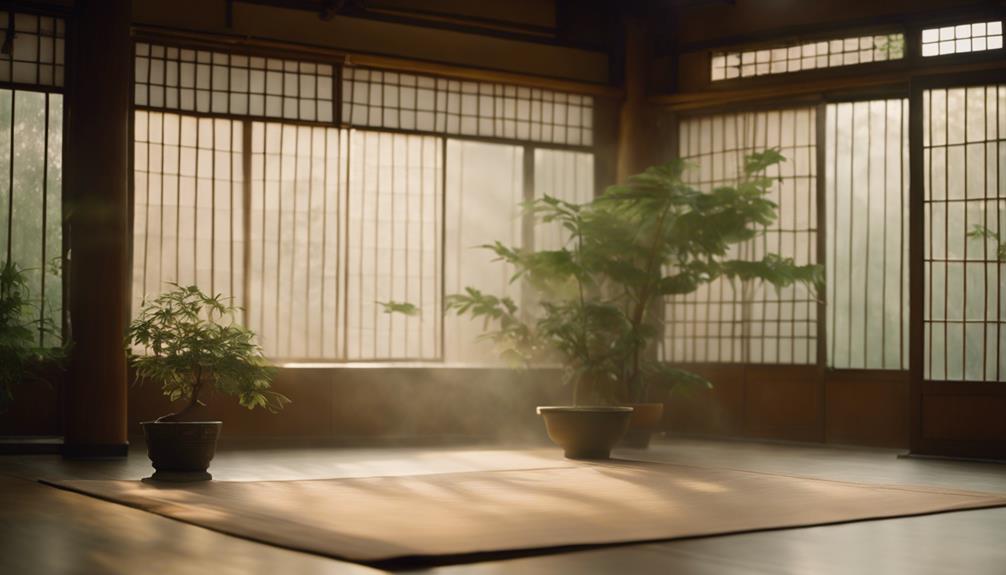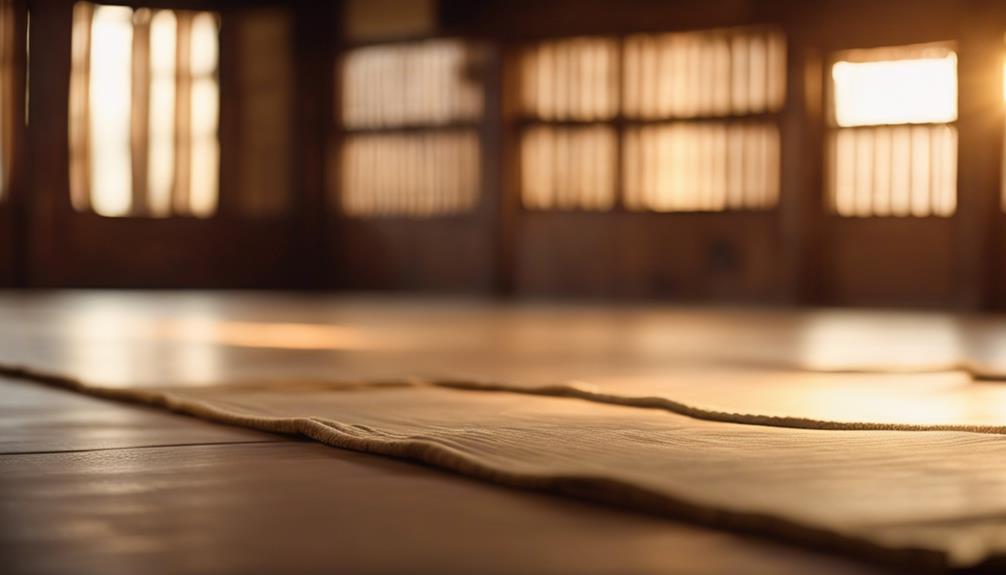As you continue to practice martial arts after 40, you'll need to adapt to age-related physical changes to prevent injuries. Your flexibility and joint mobility decrease with age, and your recovery times are slower. To compensate, focus on dynamic stretching, proper techniques, and warm-up routines that last at least 15 minutes. You should also incorporate injury prevention training, including low-impact exercises like yoga or Pilates, to enhance flexibility and core strength. By making these adjustments, you can reduce your risk of injury and maintain a healthy, lifelong training regimen. Further strategies can help you optimize your training.
Injury Prevention Training for Older Martial Artists
As you step onto the mat, into the domain of martial arts training, after the age of 40, it's with a mix of enthusiasm and apprehension – enthusiasm for the physical and mental challenges ahead, and apprehension about the risk of injuries that seem to come with the territory of aging.
Your primary concern should be injury prevention training, a vital component of a successful martial arts practice at this stage. By incorporating specific warm-up routines that include dynamic stretching, you can enhance flexibility and markedly reduce the risk of injury.
Practicing proper techniques and stances is also important to prevent joint strain and injuries. It's critical to focus on proper form to avoid excessive stress on vulnerable areas, such as your joints.
Additionally, choosing low-impact martial arts styles, like Aikido or Judo, can provide effective training while minimizing the risk of injury.
Training Regimens for Reduced Flexibility
Reduced flexibility is a natural consequence of aging, and it's essential that you adapt your martial arts training regimen to accommodate this change.
As you age, incorporating regular stretching routines into your training regimens becomes important to maintain mobility and prevent injuries. Your warm-up sessions should include dynamic stretches that target major muscle groups to improve flexibility and prepare your body for more intense physical activity.
In addition to stretching, consider incorporating activities like yoga or Pilates into your training to enhance flexibility and core strength, essential for joint health and injury prevention in martial arts.
It's also important to gradually progress in training intensity, listening to your body and adjusting your regimen to accommodate reduced flexibility to avoid strain.
Supplementing your martial arts training with low-impact exercises like tai chi or swimming can also improve overall flexibility while reducing the risk of injury.
Understanding Age-Related Physical Changes
Facing the physical realities of aging is essential for martial artists over 40, particularly when it comes to understanding the natural changes that occur in the body.
As you age, you'll likely experience decreased flexibility and joint mobility, making you more prone to injuries during physical activity. By 40, you may notice slower recovery times and heightened sensitivity to pain, requiring a more cautious approach to training.
Common age-related physical changes include decreased muscle mass and strength, affecting your overall stability and balance during martial arts movements.
The natural wear and tear on joints over time can lead to chronic issues, making it essential to prioritize joint protection and proper technique.
Additionally, hormonal changes associated with aging can impact bone density, increasing the likelihood of fractures and injuries if adequate precautions aren't taken during training.
Understanding these changes will help you adapt your training to mitigate the risks and maintain a safe, effective practice.
Effective Warm-Up and Stretching Techniques
As you prepare for martial arts training, preventing muscle strains and improving flexibility become top priorities, particularly after 40.
To achieve this, you'll need to incorporate a dynamic warm-up routine that increases blood flow and reduces muscle stiffness, making your muscles more resilient to the demands of training.
Preventing Muscle Strains
While martial arts training can be an incredibly rewarding experience, particularly after 40, it's essential that you take proactive steps to prevent muscle strains – a common injury that can quickly derail your progress.
A thorough warm-up routine, lasting at least 15 minutes, is vital in preparing your muscles for activity. Incorporate dynamic movements, such as light jogging, shoulder circles, and bodyweight squats, to increase blood flow and loosen muscles and joints.
Additionally, stretching exercises targeting major muscle groups before training can enhance flexibility and reduce the risk of strains by at least 30%. This, combined with a proper diet, will help maintain muscle resilience.
After your workout, a cooldown period with focused stretching can greatly aid in muscle recovery and decrease soreness. To further enhance muscle resilience, consider incorporating flexibility-focused activities, such as yoga, into your routine.
By taking proactive steps to prevent muscle strains, you'll be able to maintain a consistent training schedule and continue to reap the rewards of martial arts training.
Importance of Flexibility
Your ability to maintain flexibility plays a significant role in preventing muscle strains and other injuries in martial arts, particularly after 40. As you age, your joints and muscles lose elasticity, making you more prone to injuries.
Effective warm-up routines can enhance flexibility and reduce the risk of injury during martial arts training. Aim for at least 15 minutes of sustained stretching to improve your range of motion and prepare your body for physical activity.
Incorporating specific flexibility exercises, such as leg swings and arm circles, can help target key muscle groups and joints used in martial arts. Regular practice of flexibility-enhancing activities, such as yoga, can also contribute to overall joint health and reduce the likelihood of injuries.
Dynamic Warm-Up Techniques
Numerous studies have demonstrated that a well-designed dynamic warm-up is essential for martial artists over 40, as it substantially reduces the risk of injury and enhances overall performance.
When you engage in dynamic warm-up techniques, you'll be preparing your body for the demands of martial arts training. A dynamic warm-up should last at least 10-15 minutes and include movements that elevate your heart rate and increase blood flow to your muscles, such as leg swings, arm circles, and high knees.
Incorporating mobility exercises, like hip openers and shoulder dislocates, helps improve joint flexibility and prepares your body for the range of motion required in martial arts techniques.
As you progress, incorporate dynamic stretches, such as walking lunges and inchworms, which enhance muscle elasticity and reduce stiffness.
Gradually increase the intensity of your warm-up, starting with low-impact movements and advancing to sport-specific drills, to minimize the risk of injury and allow your body to adapt.
By incorporating these dynamic warm-up techniques, you'll be better equipped to handle the physical demands of martial arts training and reduce your risk of injury.
A well-designed dynamic warm-up is a critical component of injury prevention and overall performance.
Low-Impact Martial Arts Disciplines

As you continue to practice martial arts after 40, it's crucial to adopt safe training methods that minimize the risk of injury.
You can achieve this by exploring modified discipline options that cater to your age group, such as Aikido, Kempo Karate, Brazilian Jiu-Jitsu, and Tai Chi, which emphasize controlled movements and low-impact techniques.
Safe Training Methods
Several low-impact martial arts disciplines are well-suited for practitioners over 40, offering a safer alternative to high-impact styles that can put excessive strain on joints.
You can adopt safe training methods by focusing on disciplines like Aikido, which emphasizes joint flexibility and body movement while minimizing impact. Kempo Karate is another option, as it prioritizes technique and form to build endurance safely, allowing you to train without excessive strain on your joints.
When practicing Brazilian Jiu-Jitsu, you can reduce the risk of injury by using low resistance to enhance mobility and skill development. Similarly, practicing Judo with a focus on controlled falls and techniques can help you maintain physical fitness while minimizing the likelihood of injury.
To further prevent injuries, it's crucial to incorporate proper warm-ups and stretching routines into your training. Gradually increasing training intensity also helps promote longevity in training.
Modified Discipline Options
Within the domain of martial arts, certain disciplines lend themselves to modification, allowing practitioners over 40 to engage in low-impact training that minimizes the risk of injury.
You can adapt your training to focus on technique and form, rather than high-impact sparring, and still reap the benefits of martial arts. Consider joining a martial arts school that offers modified classes or workshops specifically designed for older adults.
Some martial arts disciplines are naturally more low-impact than others. For example:
- Aikido emphasizes joint flexibility and body movement with minimal impact.
- Tai Chi promotes balance, coordination, and flexibility through gentle movements.
- Brazilian Jiu-Jitsu can be practiced with low resistance to enhance mobility and technical skill.
When selecting a martial arts school, look for classes that cater to your age group and fitness level.
Many schools offer modified classes or private lessons that can help you get started with a new discipline. By choosing a low-impact martial art and training with a qualified instructor, you can minimize your risk of injury and enjoy the many benefits of martial arts training.
Nutrition and Self-Care for Martial Artists
Beyond the physical demands of martial arts training, a vital component of success for practitioners over 40 lies in the often-overlooked domain of nutrition and self-care. Proper nutrition is essential, as a diet rich in whole foods, such as vegetables and lean meats, helps support bodily functions and enhances recovery from training.
Consuming processed foods, sugars, and excessive alcohol can hinder physical performance and increase inflammation, making healthy eating habits essential for peak training results. You should prioritize nutrition to support your training, focusing on whole foods that provide the necessary nutrients for recovery.
In addition to nutrition, self-care practices greatly contribute to physical and mental recovery. You need to stay adequately hydrated and aim for 6-7 hours of sleep per night.
Regular rest days allow for necessary recovery, helping to prevent over-exertion and injuries while improving overall performance. Engaging in community activities related to martial arts also fosters social connections and motivation, which can enhance adherence to self-care and nutrition practices.
Modifying Techniques for Injury Prevention

As you establish a solid foundation of nutrition and self-care, you'll want to focus on adapting your martial arts techniques to minimize the risk of injury. This involves modifying your training to accommodate any existing injuries or physical limitations, guaranteeing that movements remain within a safe range of motion.
To do this, prioritize proper technique over power, especially in high-impact activities like kicks and strikes.
You'll also need to incorporate low-impact variations of techniques, such as practicing ground movements in Brazilian Jiu-Jitsu with controlled resistance. This will help reduce the risk of injury and allow you to take a day off when needed without worrying about falling behind.
Some key considerations for modifying techniques include:
- Focusing on controlled, precise movements rather than relying on brute force
- Incorporating gentle stretching and mobility exercises into your warm-up routine
- Regularly consulting with instructors for feedback on technique adjustments and to guarantee that training practices align with individual capabilities
Safe Training Practices and Equipment
Martial arts practitioners over 40 require a careful approach to training to minimize injury risks. To adopt safe training practices, you must prioritize proper warm-ups and stretching routines. Spend at least 15 minutes on sustained stretching to prepare your muscles and joints for activity. This simple habit markedly reduces the risk of injuries.
In addition to preparing your body, utilize protective gear such as helmets and mouthguards during practice. This equipment helps mitigate the risk of injuries from impacts and falls.
As you progress in your training, focus on gradual intensity increases, allowing your body to adapt to physical demands without feeling overwhelmed. Emphasize technique over power, especially if you have prior injuries or age-related limitations. This approach prevents excessive strain on your joints.
Regular check-ins with your instructors are also vital for safe training. They assess your technique and provide feedback, ensuring you're practicing safely and effectively.
Managing Training Intensity and Recovery

Managing Training Intensity and Recovery
Over 40, your body's recovery time increases considerably, making it vital to manage your training intensity effectively. As you age, your muscles, joints, and lower back require more time to recover from intense physical activity.
To accommodate this change, you must gradually increase your training intensity to reduce the risk of injury.
To prioritize recovery, focus on the following key strategies:
- Allow sufficient rest days to enable your body to repair and rebuild muscle tissue.
- Guarantee 6-7 hours of sleep each night for peak physical and mental rejuvenation.
- Incorporate structured warm-up routines lasting 15 minutes to enhance flexibility and prepare muscles and joints for training.
In Summary
You've got the skills, but age is catching up. By incorporating injury prevention training, modifying techniques, and adopting safe training practices, you minimize risks. Balance intensity and recovery, and prioritize nutrition and self-care. Stay flexible with low-impact disciplines and effective warm-up routines. Your body undergoes age-related changes; understanding these changes and taking proactive steps guarantees a lasting martial arts career. Stay safe, train smart, and adapt – your martial arts journey doesn't have to end at 40.



